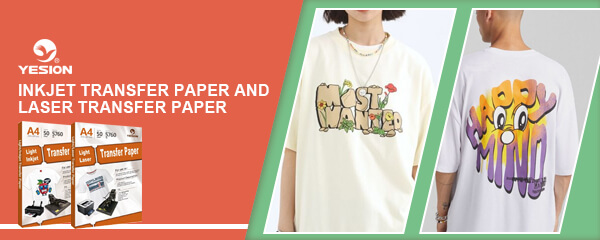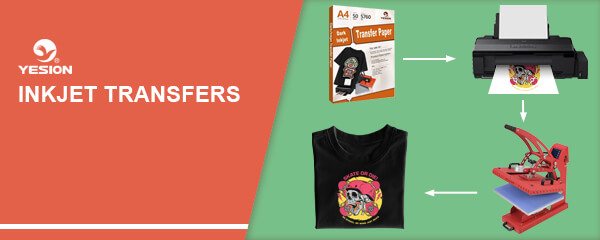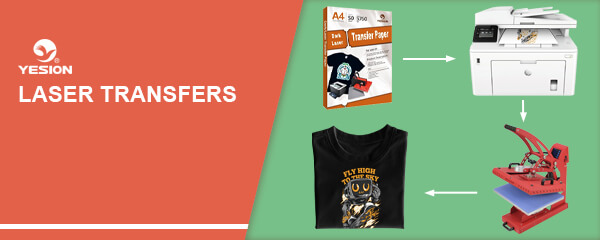
The best heat transfer paper: Your Ultimate Guide for 2023
2023-09-19
Iron On Transfer Paper: pros and cons
2023-09-26Transfer papers have become a popular choice for individuals and businesses looking to create custom designs on various surfaces. They offer a convenient and cost-effective way to transfer images, text, or graphics onto fabrics, ceramics, wood, and more.
Inkjet transfer paper and laser transfer paper, two different options for transferring designs onto fabrics using heat. In this article, we will explore the key differences between inkjet transfer paper and laser transfer paper, their applications, and the factors to consider when choosing the right type for your needs.
What is the difference between laser paper and inkjet paper?
Inkjet Transfer Paper
How does Inkjet Transfer Paper work?
Inkjet heat transfer paper is specifically designed to work with inkjet printers. It has a unique coating that allows the ink to be absorbed and transferred to the desired surface. The process involves printing the image onto the transfer paper using an inkjet printer and then using heat to transfer the design onto the desired material.
Applications of Inkjet Transfer Paper
Inkjet transfer paper is commonly used for creating custom designs on fabrics, such as t-shirts, tote bags, and aprons. It is also suitable for transferring images onto ceramics, wood, and other compatible surfaces. This makes it a popular choice for DIY projects, personalized gifts, and small-scale production.
Advantages of Inkjet Transfer Paper
Wide availability: Inkjet printers are widely available and relatively affordable, making inkjet transfer paper a popular choice for home users and small businesses.
Versatility: Inkjet transfer paper can be used on a variety of surfaces, including fabrics and hard materials, providing flexibility for different projects.
Vibrant colors: Inkjet printers are known for their ability to produce vibrant and detailed prints, which translates into high-quality transfers on the desired surface.
Limitations of Inkjet Transfer Paper
Durability: Inkjet transfers may not be as durable as those created with laser transfer paper. The ink can fade over time or when exposed to harsh washing conditions.
Limitations on fabric types: Inkjet transfers work best on fabrics with a high cotton content. They may not adhere well to synthetic or blended fabrics, resulting in a less vibrant and long-lasting transfer.
Image limitations: Inkjet transfer paper may not produce the best results for designs with intricate details or gradients. The inkjet printing process is better suited for solid colors and bold graphics.
Laser Transfer Paper
How does Laser Transfer Paper work?
Laser heat transfer paper is designed for use with laser printers or copiers. It utilizes a two-step process: printing the design onto the transfer paper and then transferring it to the desired surface using heat. The toner from the laser printer is transferred onto the material, resulting in a durable and long-lasting image.
How to use yesion laser transfer paper?
For more transfer paper videos, please follow our Youtube channel.
Applications of Laser Transfer Paper
Laser transfer paper is commonly used for creating custom designs on fabrics, such as t-shirts, sweatshirts, and jerseys. It is also suitable for transferring images onto hard surfaces like ceramics, glass, and metal,you can choose laser uncoated transfer paper. Laser transfer paper is a popular choice for small businesses, sports teams, and individuals looking for high-quality, long-lasting transfers.
Advantages of Laser Transfer Paper
Durability: Laser transfers are known for their durability and resistance to fading, making them suitable for applications that require frequent washing or exposure to harsh conditions.
Compatibility with various fabrics: Laser transfer paper can be used on a wide range of fabrics, including synthetic fibers and blends, without compromising the quality of the transfer.
Detailed designs: Laser printers can produce sharp and detailed prints, allowing for high-quality transfers of intricate designs, text, and gradients.
Limitations of Laser Transfer Paper
Cost: Laser printers and copiers tend to be more expensive than inkjet printers, which can make the initial investment higher for those looking to use laser transfer paper.
Limited availability: Laser transfer paper may be less readily available compared to inkjet transfer paper, and there may be fewer options in terms of brands and types.
Dark fabric limitations: While laser transfer paper works well on light-colored fabrics, it may not produce satisfactory results on dark or colored fabrics. In such cases, additional steps like using a white base layer or purchasing specific laser transfer paper for dark fabrics may be necessary.
Choosing the Right Transfer Paper
When selecting the appropriate transfer paper for your needs, consider the following factors:
Printer compatibility: Inkjet transfer paper is compatible with inkjet printers, while laser transfer paper is designed for laser printers or copiers. Determine whether you have an inkjet or laser printer, as this will dictate which type of transfer paper you can use.
Surface compatibility: Consider the material onto which you want to transfer the design. Certain transfer papers are specifically designed for fabrics, while others are suitable for hard surfaces like ceramics or metal.
Image complexity: Evaluate the complexity of your design. If you have intricate details, gradients,or photographs, laser transfer paper may be the better choice due to its ability to produce sharp and detailed prints.
Durability requirements: If you’re looking for long-lasting transfers that can withstand frequent washing or exposure to harsh conditions, laser transfer paper is generally more durable than inkjet transfer paper.
Budget: Consider the cost of the transfer paper and any additional equipment required, such as printers or heat presses. Inkjet transfer paper is often more affordable upfront, but laser transfer paper may offer greater durability and versatility in the long run.
In conclusion, both inkjet transfer paper and laser transfer paper have their advantages and limitations. Inkjet transfer paper is versatile, widely available, and suitable for a range of surfaces, making it a popular choice for DIY projects. Laser transfer paper, on the other hand, offers durability, compatibility with various fabrics, and the ability to produce detailed designs. Understanding the differences between these two types of transfer paper will help you make an informed decision based on your specific needs and desired outcomes.
Related:
The best heat transfer paper: Your Ultimate Guide for 2023



